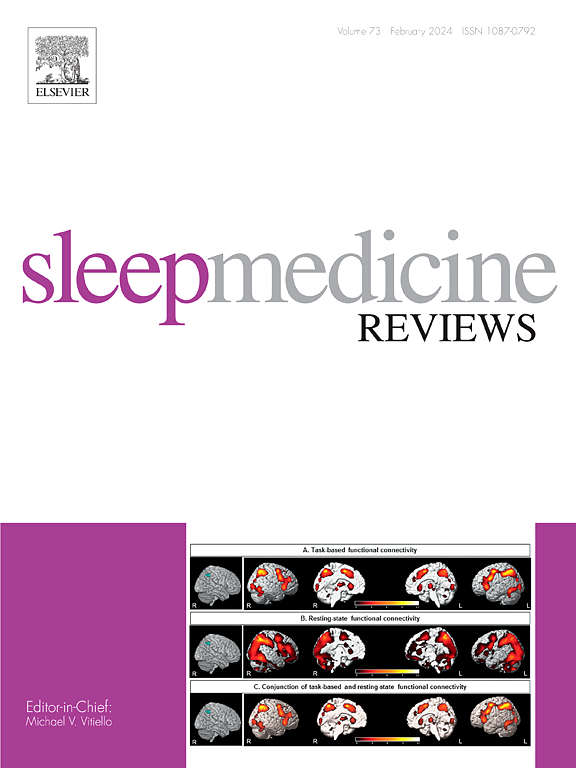Adverse events in patients with obstructive sleep apnea undergoing procedural sedation in ambulatory settings: An updated systematic review and meta-analysis
IF 11.2
1区 医学
Q1 CLINICAL NEUROLOGY
引用次数: 0
Abstract
Objective
Patients with obstructive sleep apnea (OSA) may be at increased risk for adverse events during procedural sedation, however, there remains a gap in the literature quantifying these risks. This systematic review and meta-analysis aimed to evaluate the risk of peri-procedural adverse events in OSA patients undergoing procedural sedation in ambulatory settings, compared to those without OSA.
Methods
Four databases were systematically searched for studies published from January 1, 2011 to January 4, 2024. The inclusion criteria were: adult patients with OSA undergoing procedural sedation in ambulatory settings, peri-procedural adverse events reported, and control group included. The primary outcome was the incidence of peri-procedural adverse events amongst patients with vs without OSA.
Results
Nineteen studies (27,973 patients) were included. The odds of respiratory adverse events were significantly increased for patients with OSA (OR 1.65, 95 % CI 1.03–2.66, P = 0.04). Furthermore, the odds of requiring an airway maneuver/intervention were significantly greater for patients with OSA (OR 3.28, 95 % CI 1.43–7.51, P = 0.005). The odds of cardiovascular adverse events were not significantly increased for patients with OSA.
Conclusion
Patients with OSA undergoing procedural sedation in ambulatory settings had 1.7-fold greater odds of respiratory adverse events and 3.3-fold greater odds of requiring airway maneuvers/interventions.
阻塞性睡眠呼吸暂停患者在门诊环境中接受程序性镇静的不良事件:一项最新的系统回顾和荟萃分析。
目的:阻塞性睡眠呼吸暂停(OSA)患者在程序性镇静过程中发生不良事件的风险可能增加,然而,文献中对这些风险的量化仍然存在空白。本系统综述和荟萃分析旨在评估在门诊环境中接受程序性镇静的OSA患者与非OSA患者的围手术期不良事件风险。方法:系统检索2011年1月1日至2024年1月4日发表的文献。纳入标准为:在门诊环境中接受程序性镇静治疗的OSA成年患者,报告了术中不良事件,并纳入对照组。主要结局是OSA患者与非OSA患者的手术期间不良事件发生率。结果:纳入19项研究(27,973例患者)。OSA患者发生呼吸系统不良事件的几率显著增加(OR 1.65, 95% CI 1.03-2.66, P = 0.04)。此外,OSA患者需要气道操作/干预的几率明显更高(OR 3.28, 95% CI 1.43-7.51, P = 0.005)。OSA患者发生心血管不良事件的几率没有显著增加。结论:在门诊环境中接受程序性镇静的OSA患者发生呼吸不良事件的几率高出1.7倍,需要气道操作/干预的几率高出3.3倍。
本文章由计算机程序翻译,如有差异,请以英文原文为准。
求助全文
约1分钟内获得全文
求助全文
来源期刊

Sleep Medicine Reviews
医学-临床神经学
CiteScore
20.10
自引率
3.80%
发文量
107
期刊介绍:
Sleep Medicine Reviews offers global coverage of sleep disorders, exploring their origins, diagnosis, treatment, and implications for related conditions at both individual and public health levels.
Articles comprehensively review clinical information from peer-reviewed journals across various disciplines in sleep medicine, encompassing pulmonology, psychiatry, psychology, physiology, otolaryngology, pediatrics, geriatrics, cardiology, dentistry, nursing, neurology, and general medicine.
The journal features narrative reviews, systematic reviews, and editorials addressing areas of controversy, debate, and future research within the field.
 求助内容:
求助内容: 应助结果提醒方式:
应助结果提醒方式:


